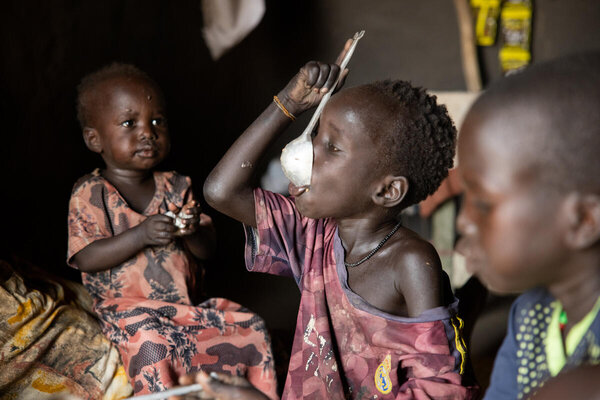Hunger hotspots in South Sudan at tipping point as food insecurity nears record levels
This is an update on food security and WFP operations in the affected regions.
Food Security Situation
- As the pre-harvest lean season begins in South Sudan, almost 7.7 million people face levels of hunger categorised as crisis, emergency, or catastrophic (IPC3+). This is close to record highs.
- Some 3.1 million of these people are in the conflict-hit Greater Upper Nile region in South Sudan’s northeast.
- The northern part of Greater Upper Nile region (Upper Nile state) is the most impacted by the escalation of conflict; one million people there face high levels of hunger.
- More than 1.1 million people have fled to South Sudan since the beginning of the Sudan war, most arriving in Upper Nile. Almost half of those currently facing catastrophic (IPC5) levels of hunger in South Sudan are returnees from Sudan.
- WFP is aiming to bring food assistance to more than 450,000 people in Upper Nile state, prioritizing those facing emergency and catastrophic levels of hunger (IPC4 + 5), but active conflict is slowing progress.
- The United Nations Humanitarian Air Service (UNHAS), managed by WFP, continues to provide passenger and cargo flights to conflict-affected locations in Upper Nile. This vital airbridge is essential to ensure support continues to reach people in Upper Nile state.
- WFP has more than 9,000 metric tons of food – enough to feed more than one million people for a month – in the northern town of Malakal, with additional food in Bor and the capital Juba.
- Upper Nile state has also been heavily impacted by a cholera outbreak. The WFP-led Logistics Cluster has airlifted 35 metric tons of cholera and WASH supplies to conflict-affected locations with another three metric tons ready for transport.
- Another 148 metric tons of nutrition and shelter/protections supplies planned for river transport by the Logistics Cluster are currently in Malakal awaiting delivery when security allows.
- Insecurity has forced WFP to pause distributions in six counties in the region for the safety of our staff, partners and the people we serve. WFP and partners have the food ready to deliver and distribute once conditions allow.
- Increased tensions and fighting along the rivers used by WFP as supply routes is hindering the transport of food assistance for Upper Nile state.
- The safety of staff, the people we support, and humanitarian supplies and assets, is paramount. We have no choice but to pause operations in areas where there is a risk to any of these.
- WFP has a US$396 million funding shortfall for the rest of 2025.
WFP Response and Food Stocks
- WFP is aiming to bring food assistance to more than 450,000 people in Upper Nile state, prioritizing those facing emergency and catastrophic levels of hunger (IPC4 + 5), but active conflict is slowing progress.
- The United Nations Humanitarian Air Service (UNHAS), managed by WFP, continues to provide passenger and cargo flights to conflict-affected locations in Upper Nile. This vital airbridge is essential to ensure support continues to reach people in Upper Nile state.
- WFP has more than 9,000 metric tons of food – enough to feed more than one million people for a month – in the northern town of Malakal, with additional food in Bor and the capital Juba.
- Upper Nile state has also been heavily impacted by a cholera outbreak. The WFP-led Logistics Cluster has airlifted 35 metric tons of cholera and WASH supplies to conflict-affected locations with another three metric tons ready for transport.
- Another 148 metric tons of nutrition and shelter/protections supplies planned for river transport by the Logistics Cluster are currently in Malakal awaiting delivery when security allows.
Access challenges
- Insecurity has forced WFP to pause distributions in six counties in the region for the safety of our staff, partners and the people we serve. WFP and partners have the food ready to deliver and distribute once conditions allow.
- Increased tensions and fighting along the rivers used by WFP as supply routes is hindering the transport of food assistance for Upper Nile state.
- The safety of staff, the people we support, and humanitarian supplies and assets, is paramount. We have no choice but to pause operations in areas where there is a risk to any of these.
Funding
WFP has a US$396 million funding shortfall for the rest of 2025.
# # #
The United Nations World Food Programme is the world’s largest humanitarian organization saving lives in emergencies and using food assistance to build a pathway to peace, stability and prosperity for people recovering from conflict, disasters and the impact of climate change.
Follow us on X, formerly Twitter, via @wfp_SouthSudan


